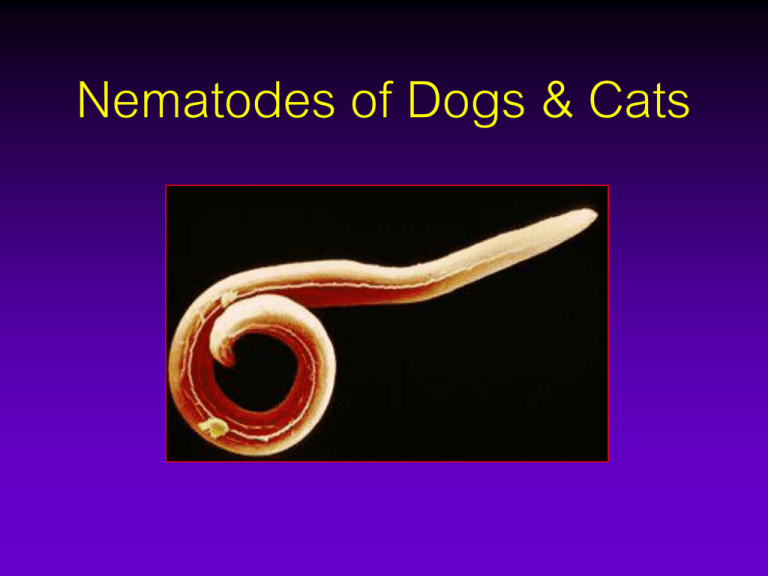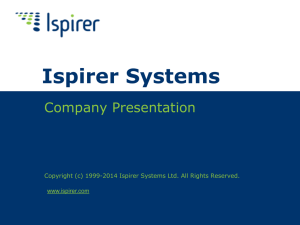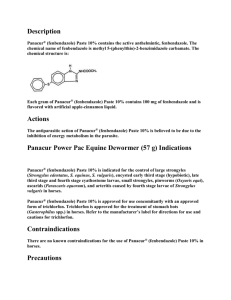Nematodes of Dogs
advertisement

Nematodes of Dogs & Cats Toxocara sp. Significance • the most important parasites • infection at birth • death: first two weeks (lung migration) • larval migration Morphology male female = = 4-10 cm 5-18 cm T. canis cervical alae: - long & narrow - semilanceolate cervical alae: - broader - arrow head Life cycle • modes of transmission: T. canis • transplacenta • transcolostrum • direct ingestion • paratenic host Direct life cycle 10-15 d tracheal migration age < 3 mths prepatent period 4-5 weeks Indirect life cycle (age > 3 mths) prepatent period 3-5 weeks (neonates) 10-15 d somatic migration transplacenta transcolostrum paratenic hosts > 42 d gestation Life cycle • Toxocara cati: • direct ingestion • paratenic host • no prenatal transmission Effect on host • adult: no clinical signs • puppies: severely affected, pneumonia signs: vomiting, emaciation, potbelly, obstruction, dull coats death: 2-3 weeks after birth Diagnosis T. canis T. cati Infective stage Ascarid egg SEM differentiation large, coarse pitted surface small, fine pitted surface Uga et al., Vetrinary Parasitology 92(2000): 287-294 Treatment ivermectin fenbendazole pyrantel dichlorvos febantel piperazine • Saprophytic soil fungi • Paecilomyces sp. • Ovicidal activity of T. canis (Basualdo J.A., 2000) • Use of ivermectin during pregnancy 1) dose: 300 mcg/kg on day 0, 30, and 60 of gestation - reduce # worms by 90% - reduce # eggs by 99.8% • Use of ivermectin during pregnancy 2) dose: 300 mcg/kg on day 0, 30, 60 of gestation, 10 d post whelping - reduce # worms by 100% - no eggs were passed in environ. (Payne P.A., 1999) • Selamectin • topical administration • dose: 6 mg/kg (6-12 mg/kg) • reduce # adults by 93.9-98.1% • reduce # eggs by 90-95% (McTier T.L., 2000) Control • good sanitation • regular deworming • anthelmintics: •2, 4, 6 weeks of age Public Health • visceral larva migrans (T. canis): • children: chronic granulomatous – liver, lung, brain, eye • ocular larva migrans • choroidoretinitis Toxascaris leonina (arrowhead worm) head: lanceolate cervical alae male: up to 7 cm female: up to 10 cm Life cycle • transmission: • direct ingestion • paratenic host • no larval migration • prepatent period = 8-10 weeks Effect on host • puppy: potbelly, intermittent diarrhea, poor condition, intestinal obstruction Diagnosis T. canis T. leonina Treatment piperazine dichlorvos pyrantel fenbendazole febentel + praziquantel Ancylostoma caninum (Hookworm) Ancylostoma caninum • Geographic distribution – temperate climates – worldwide • Significance – very important – causes deaths (all ages) – causes heavy blood losses Morphology • worms: red or gray • size: up to 1.6 cm • mouth: 3 pairs of prominent teeth Life cycle modes of infection: 1. eating (infective eggs) 2. skin penetration (larvae) tracheal migration Life cycle modes of infection: • intrauterine infection • transcolostrum • paratenic host prepatent period = 15-18 days H O O K W O R M S A N C Y L O S T O M A คัน! moist eczema & ulceration Larval penetration effect on dog “pale mucous membrane” effect on dog “severe blood loss” effect on dog blood vessels rupture & hookworms feed on the released blood (0.25 ml/day) Ancylostoma caninum Clinical signs • factors: dose, age, immune status • dermatitis • puppy pneumonia • diarrhea: dark in color (blood & mucus) Clinical signs • severe blood loss: •iron-deficiency anemia •edema, weakness, weight loss •poor coat condition heavy infection: frequently fatal within 2 weeks of birth in puppies Diagnosis • clinical signs • fecal examination: •fresh direct smear 60 x 40 microns •simple floatation ovoid, thin-shelled, morulate embryo Treatment • supportive care: blood transfusions, iron supplement • anthelmintics: fenbendazole, ivermectin, tetrahydropyrimidine (pyrantel) • Ivermectin + pyrantel • ivermectin = 6 mcg/kg • pyrantel pamoate = 5 mg/kg • 99.6 % reduction of adult hookworms (Nolan T.J. et. al, 1992) • Doramectin • 1 mg/kg on d30 of gestation reduce somatic larvae in bitches and adult hookworms in bitches and puppies (Schnieder, T. et al, 1996) • Moxidectin • 1 mg/kg on d55 of gestation (5-8 d before parturition): completely prevent lactogenic infections in puppies. (Epe, C., 1999) Deworming program • CDC recommendation: rd • bitch: fenbendazole in the 3 trimester (kill migrating larvae) • pups: 2, 4, 6, and 8 weeks of age Control • feces elimination • keep kennel-floor dry • regular deworming • treat bitch with ivermectin Effect on man • Adult Ancylostoma caninum •excretory/secretory antigens •causes hypersensitivity in man •human eosinophilic enteritis Cutaneous larval migration Cutaneous larval migration Trichuris vulpis (whipworms) Morphology size: 4.5-7.5 cm. anterior part: 3/4 of body, long & slender Life cycle • location: caecum • infection: direct ingestion of infective egg L I F E C Y C L E prepatent period = 11-12 weeks T R I C H U R I S Effect on host • intestine: irritation of caecum & large intestine • profuse diarrhea, loss of weight, unthriftiness • anemia in heavy infection Diagnosis 70-90 x 30-40 microns Lemon-shaped with bipolar plugs Treatment mebendazole dichlorvos fenbendazole febantel avermectins are not as effective. Spirocerca lupi (esophageal worm) • Definitive host • dogs • Intermediate host • coprophagous beetles • lizards, chickens, mice (paratenic host) morphology: red, coiled nematode 3-8 cm long esophagus thoracic aorta coeliac artery gastroepiploic artery prepatent period 5-6 mths adults in nodule (L1) beetles encyst larvae (L3) Effect on host • larval migration: aorta •haemorrhage •granuloma, stenosis •aneurysm, rupture Effect on host • adult: embedded in the walls of aorta, esophagus and stomach Effect on host • adult: nodules, tumor • nodules: interfere with swallowing, respiration and circulation • signs: persistent vomiting, wt. loss, hemoptysis • aneurysm burst causes sudden death “esophageal sarcoma” 10% of infected dogs Diagnosis • • • • floatation method radiography endoscopy necropsy Diagnosis • egg: small, oblong in shape, thick-shelled, larva inside 30-38 x 11-15 microns Treatment • fenbendazole • avermectins Control • isolate infected animals • dispose of the vomit and feces • keep dogs from eating beetles, paratenic hosts Strongyloides stercoralis (threadworms) Morphology • parasitic stage: pathenogenetic female • size: 2-9 mm. long • filariform esophagus Life cycle • host: dogs, cats, men • direct life cycle: free-living, parasitic • prepatent period = 7 days Life cycle • modes of infection: • skin penetration • ingestion (rare) • hyperinfection (mucosal migration) • autoinfection (perianal area) Significance • reinfection: kennel situation • causes severe disease only in young animals • heavy infection: death in puppies Effect on host • skin: dermatitis intestine: irritation, catarrhal inflammation, mucosal erosion, necrosis signs: diarrhea (blood), low appetite, weight loss, dehydration, weakness, death lung migration: alveoli destruction, ecchymotic hemorrhage, pneumonia Diagnosis • fecal examination •larvae, eggs containing larvae 40-50 microns Treatment Dichlorvos Fenbendazole Control clean & dry floor Gnathostoma spinigerum G. spinigerum • size: 1-3 cm. long • head bulb: “ballonets” • head & anterior part: spines Life cycle • • • • prepatent period: 7 months st 1 int. host: Cyclops 2nd int. host: fresh water fish, reptiles location: stomach Gnathostoma spinigerum cats, dogs nodule in the gastric wall eggs (L1) fish, frog, snake (L3) man Cyclops (L2) Effect on host • Cutaneous larva migrans: – cause intermittent, migratory, painful, priritus swelling Effect on host • visceral larva migrans: • cough, hematuria, • ocular involment • eosinophilic meningtitsis • myeloencephalitis Pathogenesis • larval migration: liver damage, mesentery, diaphragm, thoracic cavity • adult: migrate in stomach wall • cavity, pus, cyst Diagnosis • egg: rare in feces Treatment • no specific drug (albendazole) Physaloptera praeputialis Morphology • size: 1.5-4.8 cm long • body: large, thick, stout nematodes • egg: contain a larva when laid Life cycle • host: dogs, cats, other carnivores • intermediate hosts: •crickets, cockroaches, beetles • prepatent period = 41-83 days • location: stomach, duodenum • worldwide distribution Effect on host • adult •irritation: firmly attach to the lining of the gastric mucosa •bleeding, mucosa erosion •digestion interference Clinical signs • loss of condition • vomiting (possibly bloody, mucoid) • anorexia Diagnosis • fecal examination (floatation) •small, oblong eggs containing larvae 40-58 x 30-34 microns Treatment • anthelmintics •dichlorvos, benzimidazoles, avermectins • control pets’ eating habits











